Why Rent A Rock CLimbing Wall
Our portable rock climbing wall is a great addition to have for any party or event that you have planned. It is a fun and popular attraction that always gains a lot of attention. That’s what makes it a great choice for Festivals, Company Picnics, School Fun Days, and other events where you want to draw in as many people as you can. It’s also a fun attraction for backyard parties and other events that you may have planned.
Our Rock climbing wall offers many advantages such as an increased level of fun and fitness, increased safety, increased popularity and you also get to spend more time with your friends and family. So, book our Rock Wall today and take your event to the next level!

A rock climbing wall can be a great addition to any party or event you have planned including:

Church Picnics

Company Picnics

School Carnivals & Field Days

Highschool Proms or Graduation

College Clubs and Events

Town Festivals and Events

Grand Openings

Corporate Events

Country Club Gatherings

Fundraisers/ Charity Events
...& many More
Rock Climbing Wall Safety
One of the biggest concerns people have when it comes to rock wall climbing rentals is of course about safety. You can rest assured that every precaution is made to ensure your Rock Wall Rental is safe and secure and in tip top shape before, during, and after your booking. As long as all the rules outlined in the operator safety acknowledgement form are followed, and the unit is supervised at all times, this is a very safe attraction that any event can benefit from.
Our Rock Wall can be setup on any surface as well as indoor arenas with large bay door entrances. There are also a number of other safety parameters in place as well to ensure you and your guest have a fun and safe time climbing:

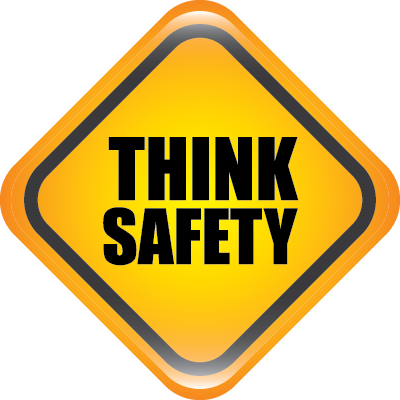
- Harness- every climber will be securely strapped into the climbing harness and will be given a brief safety review before they start their climb.
- Ropes- safety ropes will help you as you climb and will help minimize the distance you fall if you lose your footing while on your climb up the wall.
- Padding- every climber will be given knee and elbow pads to help minimize injury and to help improve safety while they are on the rock wall.
- Helmets- no climber will be allowed to go up without a helmet on and every climber will be required to keep it on until they are out of their harness.
- Staff- the rock wall climbing rental will be maintained at all times by trained and experienced staff to ensure safe operation of the rental.
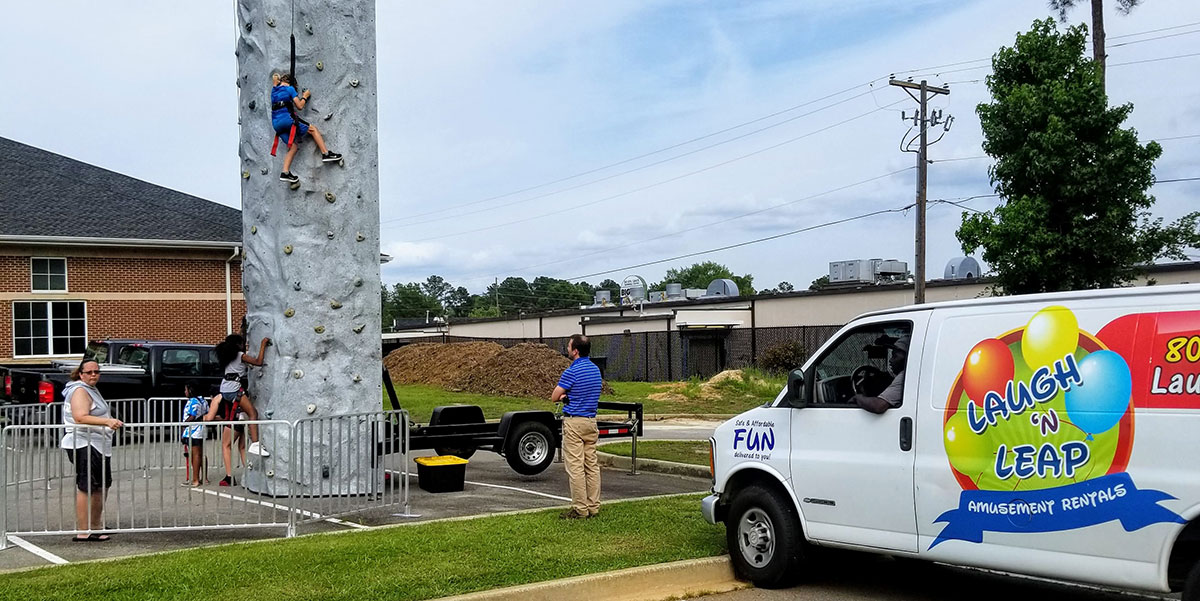
Where to rent a rock wall?
The Rock Climbing Wall experience is our most unique and exciting activity. Rock Climbing is suitable for kids, teens, and adults. Our Rock Wall can entertain 4 climbers at once, which makes it a good choice for events, school carnivals, and Festivals.
Riders will be safely harnessed into a heavy duty cable system that automatically keep climbers level as they take the 24 feet tall ascension.
We provide a full service Rock Climbing Wall attraction throughout Columbia, Aiken, Spartanburg, Charleston, Florence and all over South Carolina. It is easy to see why renting a rock wall is a great option for your next party or celebration and why they are so popular for events and parties in the area.
The best thing is; Laugh n Leap can get you the perfect party rental that is just right for your needs, at a price you can easily afford, and we will handle all the details so you can spend your time enjoying your party. Our rock wall rentals are in high demand and you do not want to miss out on our great deals and amazing options that we have available right now!
Call us today to learn more about the rock wall rental we have available. Our staff is ready to assist!

Rock Climbing Walls are great for kids’ parties, spring and fall festivals, church gatherings, school carnivals, or any other event you may have planned.

We provide commercial grade party rentals for much of the South Carolina which is why we are South Carolina’s #1 party and event specialists providing prompt and friendly services for all of your special occasions!

Our rock wall climbing set up is rented on an hourly basis.A minimum of 2 hours is required at $895.00, then additional hours are calculated at $349.99 per hour. Multi-day events are calculated based on what units you are renting and how far away you are.
Please don’t hesitate to inquire about special accommodations to meet your needs. We encourage you to contact us sooner rather than later as all of our Climbing Wall rentals are available on a “first-come, first-served” basis. Popular party dates- Spring Festivals, July 4th, Back to School, and Fall Festivals- often see our Rock Climbing attraction being reserved 4 to 6 weeks in advance. We suggest 2-4 weeks before your scheduled event date in any case and closer to 6 weeks for peak party dates. We have a large inventory so if the Rock Wall is unavailable, we have plenty of choices that can allow for a last-minute party that is still amazing.
To learn more about our rock wall rentals and other party supplies we have on hand contact us today and let us help you plan the perfect party!
How to effectively climb a Rock Wall
Of all the party rentals & amusement rides that we have available today one that is always at the top of everyone’s wish list is the rock wall. If you are planning on renting our portable rock climbing wall for your event it’s a good idea to offer your guests some quick pointers to help them get the most out of their rock climbing experience.
It’s hard to overstate the importance of good technique when it comes to learning to climb a rock wall. When you focus on technique, moves start to come to you more easily and it can really help you do better and get better results, so here are some key concepts to review in order to do your best on a rock wall:
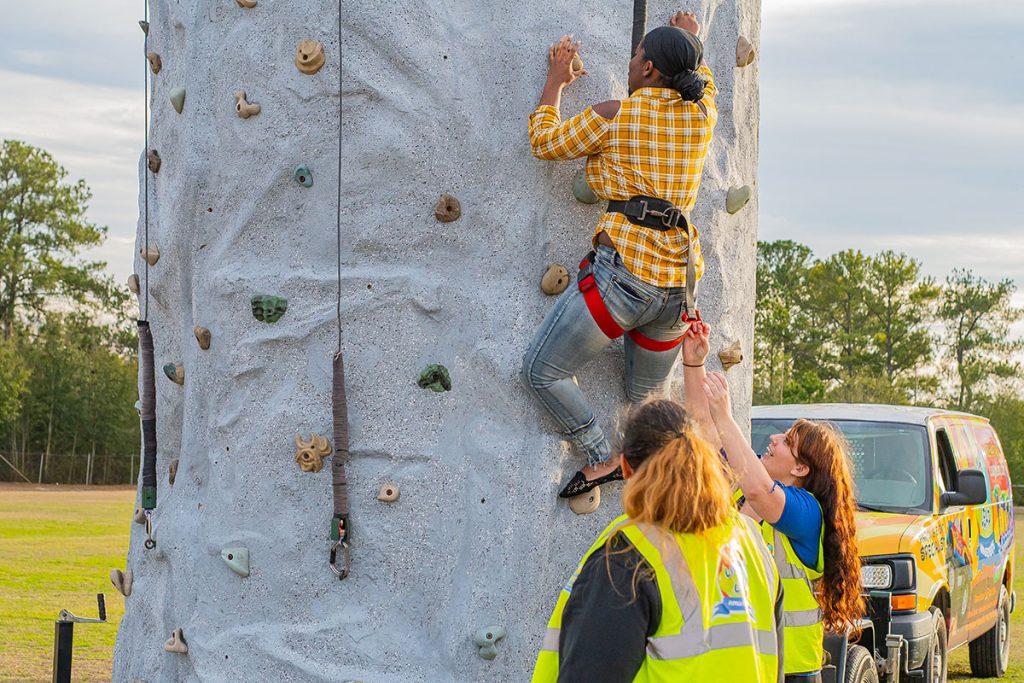
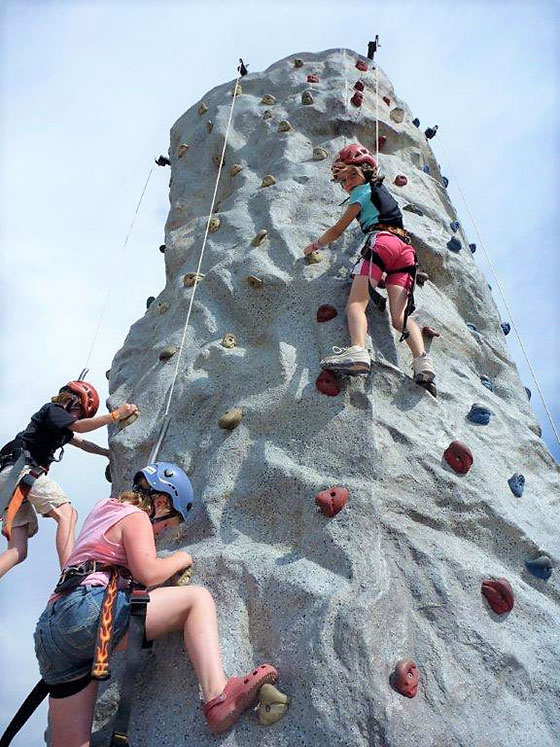
Rock Climbing Techniques: Using Your Feet
Feet are the groundwork of climbing and the number one mistake beginners make is that they try to pull themselves up the wall with their arms and quickly tire out. Think about climbing a ladder- you push yourself up with your legs and feet and use your arms to steady yourself and maneuver yourself- and the same in climbing. Basic techniques for using your feet are usually referred to as edging and smearing:
- Edging is exactly what it sounds like: Your feet and toes position on the edge of the rubber grips to push yourself around to reach other grips and footholds and to move yourself up the rock wall face bit by bit.
- Smearing is a bit more complicated of a move: It happens when there are no actual footholds for your feet, so you have to rely on your shoe’s sole to provide the friction against the rock face to move you along.
It can be helpful to keep the following footwork tactics in mind when climbing your rock wall:
- Try to keep your feet under you and avoid stretching out too far to reach foot and hand holds
- Keep an eye out for footholds that are easy to get to and don’t over reach or show off
- Look for foot placements first then handholds as you can push and stabilize with one hand
- Once you set your foot avoid moving it around too much and focus on pushing from there
- Keep your heel low so you have plenty of contact with the wall as you move up
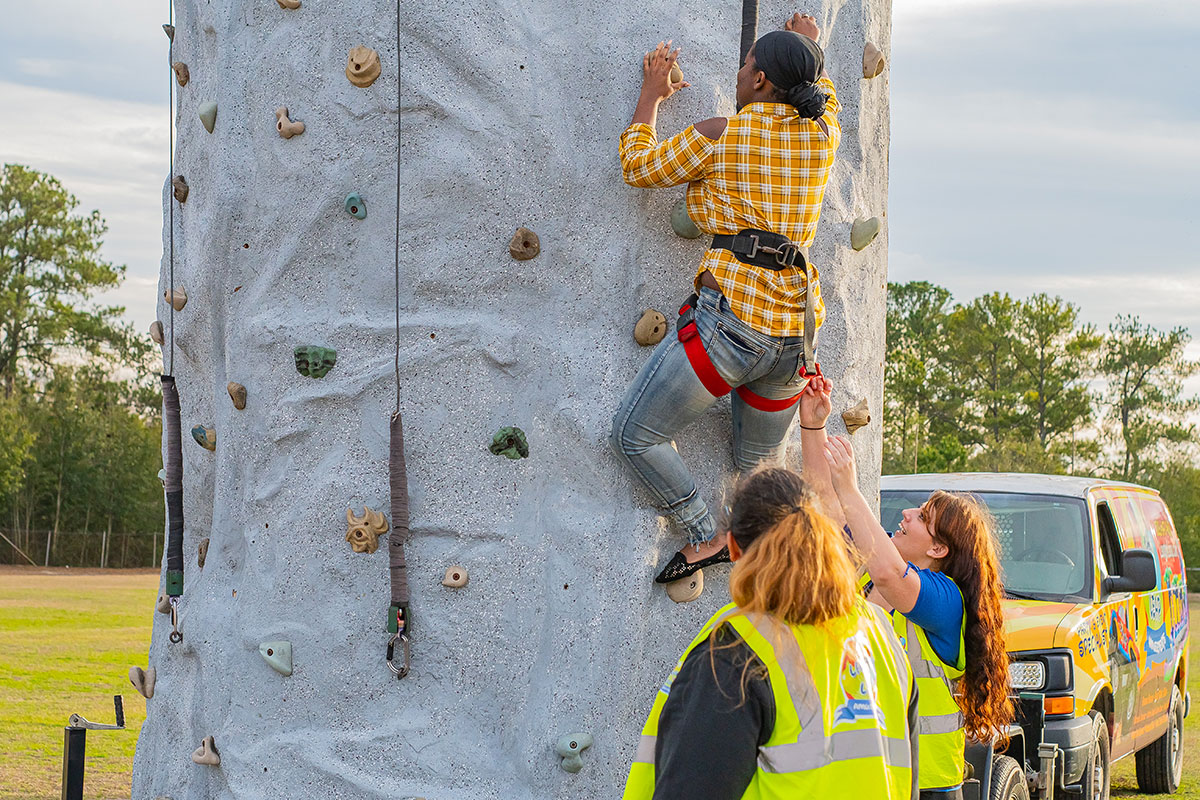
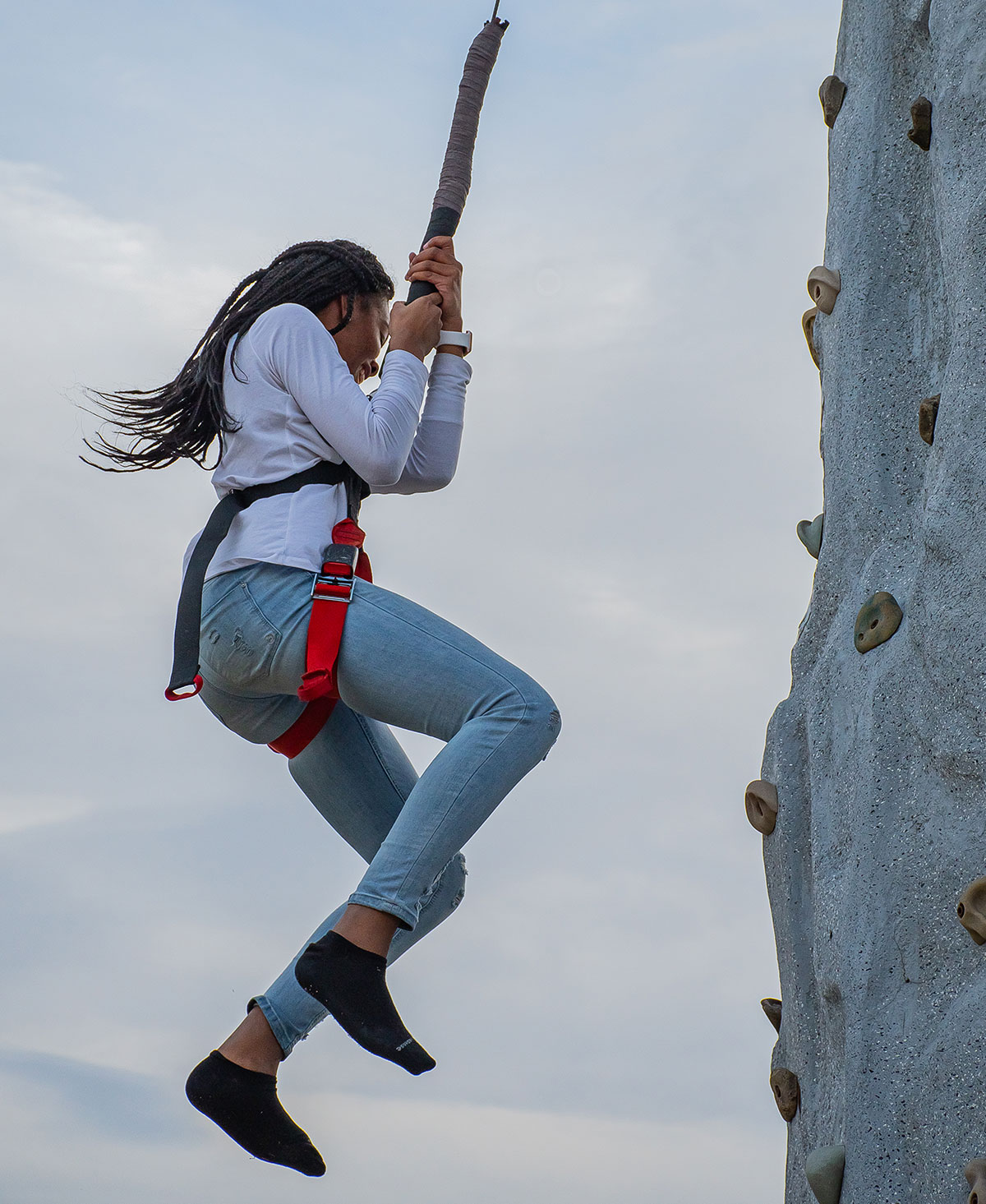
Rock Climbing Techniques: Maintaining Balance
When you’re lucky enough to find hand and foot holds in good positions that leading straight up the wall, climbing is fairly intuitive. When you’re on a route where you have to move and pull in different directions, though, you have to use your body to maintain balance. This is key to being successful with the climb and is one of the hardest parts for new climbers to master. Balance can be a challenge but once you learn the basics it can be much easier to implement and you will soon find yourself climbing up the rock wall.
Balancing tactics that can help you maximize the power of your climb include the following:
- Press your foot in the opposite direction of the direct that you are pulling in order to create counter pressure which can help keep you balances and in place for a little longer.
- Pull in the opposite direction that you are reaching for with your other hand or a hooked foot to give yourself some stability so you don’t totally lose your balance and fall.
- Lean over hard and use your body weight as a counter balance and if you need to stop to search for a hand or foot hold or to catch your breath keep yourself anchored as you do so.
Rock Climbing Techniques: Climbing Efficiently
It’s an advanced climbing skill but over time you can learn to use less energy and can find ways to figure out how to give your muscles a break as you climb. Here are some ideas to help you climb efficiently:

- Straight arms are strong arms and keeping your arms straight as possible while climbing allows your skeleton to take most of the weight, not your muscles. Bending your arms just a little puts strain on your muscle sand will start wearing you down as you climb.
- Focus on your hips when you are climbing and focus on how you are holding your weight. Beginners often keep their hips squared to the wall, which feels better as far as stability goes but is not as efficient when it comes to delivering power and energy to the wall.
- Try to keep one hip in contact with the wall while you climb. That helps keep your weight over your feet and also gives you a bit more of a pivot point to lean back with straight arms and continue your climb up the wall towards the top.

- Good climbers learn very quickly to climb with their eyes. Keep your eyes on the wall ahead of you rather than looking down at your feet. Keep eyes ahead to look for holds that let you take a quick rest and glance down only to ensure your foot is secured on a foothold.
- When you find a good resting point during your climb, use it. Allow your pulse to slow down a little if needed and take a few second to shake out your arms so they don’t get overly tired and worn out later on toward the top of your climb.
Rock Climbing Wall Rental in South Carolina
Our Rock Climbing Wall is 24 feet tall and an guaranteed crowd pleaser at events!
Camps, schools, colleges, churches, & corporations are some of the most notable clients we’ve provided the Ultimate Rock Climbing Experience for.
Request a quote instantly!
What our customers say!

“I’m more than satisfied with the Rock Climbing experience provided by your company for our church’s annual fall festival. It wasn’t easy convincing the committee to have a Rock Wall at the event, but they were all saying how much of a success it was. From the planning all the way to the removal of the wall, you guys were absolutely top notch! Thanks for accomodating our church with the best customer service we could’ve ever hoped for.”
- Anthea Cox
Columbia, SC

“You guys provided a tall Rock Climbing Wall for our senior fun day at school and it was the best! It was our first time having such a major attraction for our senior class. We had a blast. I’m writing this review because I felt like it’s important to let other organizations know how much fun we had. Hopefully our Principal will allow next year’s class to rent the Rock Wall too.”
- Bert Lee
Florence, SC

“Our Employee Appreciation Day was a huge success, Thanks to the Rock Climbing Wall! The kids and adults enjoyed the experience of climbing the wall. We’re already looking forward to the next Rock Wall Event ahead. See ya soon! Thanks for the superb customer service!”
